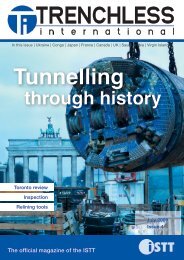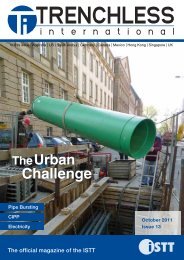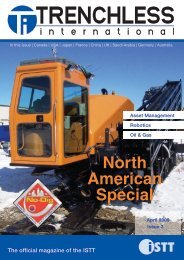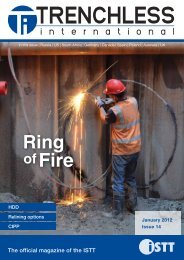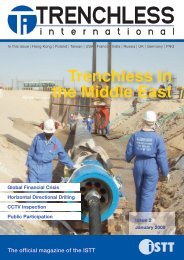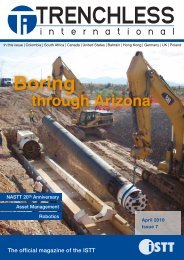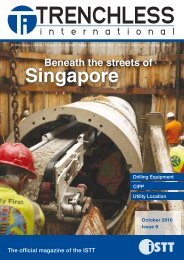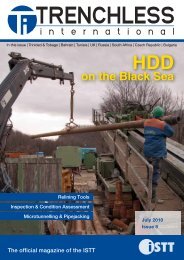tunnel's - Trenchless International
tunnel's - Trenchless International
tunnel's - Trenchless International
Create successful ePaper yourself
Turn your PDF publications into a flip-book with our unique Google optimized e-Paper software.
A crew member helps angle the TBM.<br />
SEE US AT<br />
27<br />
BOOTH NO.<br />
CEO at European XFEL GmbH Dr<br />
Massimo Altarelli said “Tunnelling is one of<br />
the most difficult areas of the construction.”<br />
Dr Helmut Dosch, Chairman of the<br />
Deutsche Elektronen-Synchrotron DESY<br />
Board, head shareholder of the European<br />
XFEL GmbH said “Completion of tunnelling<br />
work on time has enabled us to achieve<br />
a key milestone for this unique research<br />
facility. And now there’s nothing to stop the<br />
installation of technical infrastructure and<br />
accelerator components.”<br />
For more information visit<br />
www.herrenknecht.com<br />
For more news, information<br />
and projects involving<br />
Tunnelling, visit:<br />
Ameli and Tula<br />
bring light to Hamburg<br />
TUNNELLING<br />
www.trenchlessinternational.com/resource<br />
Innovators in <strong>Trenchless</strong> since 1962<br />
One of the TBMs utilised to excavate a complex tunnel system network in Germany.<br />
projects<br />
October 2012 - <strong>Trenchless</strong> <strong>International</strong><br />
Excavation of a tunnel system for the X-ray Free-Electron Laser European Research Facility in<br />
metropolitan Hamburg, in Northern Germany, was successfully completed in June 2012 following a<br />
Herrenknecht tunnel boring machine, named Ameli, entering its last target shaft.<br />
For the project, two Herrenknecht<br />
tunnel boring machines (TBM) covered<br />
a total distance of 5.78 km between<br />
July 2010 and June 2012.<br />
Ameli and its TBM sister Tula had to<br />
be relocated several times for the eleven<br />
tunnel sections between the research<br />
centre DESY in Hamburg Bahrenfeld, and<br />
Schenefeld in the district of Pinneberg. Laser<br />
technology provided by the Gesellschaft für<br />
Vermessungstechnik kept the two TBMs on<br />
course over the route.<br />
As of 2015, electron and x-ray light will<br />
be flowing through the European X-ray<br />
Free-Electron Laser (XFEL) research project<br />
tunnel system.<br />
Steffen Benad from Herrenknecht said<br />
“Technically, the tunnel system is extremely<br />
complicated.”<br />
The European XFEL basically consists<br />
of underground structures and a ramified<br />
tunnel system. In the main tunnel,<br />
electrodes are accelerated to practically<br />
the speed of light. They are then brought<br />
to the point of transmitting highly intensive<br />
X-ray laser flashes with the aid of special<br />
magnetic fields in a tunnel fan. Through<br />
them absolutely new opportunities for<br />
research in the nano field are opened up<br />
for scientists and industrial users alike.<br />
In this way, atomic details of viruses and<br />
cells can be deciphered, 3-D recordings<br />
from the nano-cosmos made and chemical<br />
reactions filmed.<br />
Up to 27,000 ultra-short laser flashes<br />
per second will be generated in the x-ray<br />
range by XFEL with the aim of enabling,<br />
for example, the shooting of chemical<br />
reactions, and giving rise to entirely new<br />
research opportunities for physicists,<br />
biologists, chemists, doctors and material<br />
scientists.<br />
The two 500 and 560 t Mixshields with<br />
diameters of 6.16 m and 5.45 m were<br />
baptised Tula (tunnel for laser) and Ameli<br />
(Am Ende Licht – light at the end). They<br />
were used by Hochtief AG and Bilfinger<br />
Berger AG for excavating the complex<br />
tunnel system network.<br />
In order to keep them exactly on course<br />
in the 3.4 km plant, Herrenknecht used a<br />
laser-guided navigation system from VMT,<br />
subsidiary of Herrenknecht AG based in<br />
Bruchsal. By late July 2011, Tula had<br />
successfully completed its task for the more<br />
than 2 km long main tunnel and the two<br />
further 600 m long sections.<br />
The tube system network at the end<br />
of the tunnel proved particularly complex<br />
for the engineers. The total of eight tunnel<br />
sections involved moving Ameli three times<br />
through a finished shaft and lifting it out of<br />
the shaft four times for relocation.<br />
Pipe bursting<br />
with the proven<br />
cutting technology<br />
Hardest Burst • rigid, reliable technology • QuickLock rods<br />
5 machine types • pulling force from 40 - 250 t • simple handling<br />
TRACTO-TECHNIK GmbH & Co. KG · P.O.Box 4020 · D 57356 Lennestadt<br />
Phone: +49 2723 808238 · Email: export@tracto-technik.de · www.tracto-technik.com<br />
projects<br />
October 2012 - <strong>Trenchless</strong> <strong>International</strong><br />
22<br />
23




